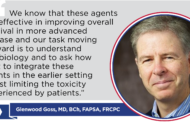Editor’s Note: For more research on the links between air pollution and lung cancer, see Researcher Reveals How Air Pollution May Cause Lung Cancer

Researchers from Vancouver, British Columbia, examined the effect of duration of past exposure to air pollution on lung cancer diagnosis in new research (abstract 2268) during IASLC’s 2022 World Conference on Lung Cancer.
The research was presented by Renelle Myers, MD, FRCPC, who is clinical associate professor of medicine at the University of British Columbia and an interventional respirologist at Vancouver General Hospital, Canada.
In 2013, the International Agency of Research on Cancer classified outdoor air pollution and particulate matter of 2.5 micrograms/meter3 (PM2.5) in outdoor air pollution as carcinogenic to humans, but the effects of air pollution exposure may take 15 to 20 years to be reflected in the lung adenocarcinoma incidence rate.
To assess the connection between pollution and lung cancer diagnosis, Dr. Myers and her colleagues compared the cumulative 3-year exposure to PM2.5 to 20-year exposure to PM2.5 in Vancouver-area females with newly diagnosed lung cancer who have never smoked.
The researchers collected detailed information on the patients’ age, sex, race, country of birth, age on arrival in Canada (for foreign-born Canadians), occupation, family history of lung cancer, and secondhand smoke exposure. A detailed residential history from birth to cancer diagnosis for residences within Canada, and prior residences outside of Canada were recorded. This geographical data included street and city address with postal codes, which allowed accurate linking of residential locations to satellite-derived PM2.5 exposure data that were available beginning in 1996.
Cumulative exposure to PM2.5 was quantified with a high-spatial resolution global exposure model. The magnitude of 3-year versus 20-year exposure were compared.

View On-Demand: Evaluation of Outdoor Air Pollution
In-person and virtual attendees can watch WCLC 2022 sessions and view e-poster presentation slides through December 31, 2022. If you couldn’t make the meeting, it’s not too late to register and enjoy on-demand content through the end of the year.
Of the 236 female patients with lung cancer who had never smoked, 190 (83.3%) were foreign born and 71% were Asian. The mean years lived in a foreign country was 37.3 years. The mean age of lung cancer diagnosis was 66 years; 92.8% of them had adenocarcinoma and 55.9% had stage III/IV lung cancer.
For foreign-born Canadian females, only four of 190 (2%) had 3-year cumulative PM2.5 exposure greater than 10 ug/m3, while 38 of 190 (20%) had a 20-year cumulative PM2.5 greater than 10 ug/m3 (p≥0.0001). All had a PM2.5 exposure greater than 5 ug/ m3.
The study data indicate that shorter-term (3-year) assessments significantly underestimate the cumulative exposure to PM2.5 prior to lung cancer diagnosis, especially among foreign-born Canadians, Dr. Myers said.
“Our study demonstrates the importance of incorporating long-term cumulative exposure to ambient air pollutants in the assessment of individual lung cancer risk in combination with traditional risk factors,” said Dr. Myers, who is the lead for the BC Cancer Smoking Cessation Program and principal investigator of the Leung Breathomics lab. “Research is needed regarding the best method to incorporate the effects of air pollution exposure prior to 1996 when accurate satellite data became available. Our finding has important clinical implication in assessing lung cancer risk with global migration.”





